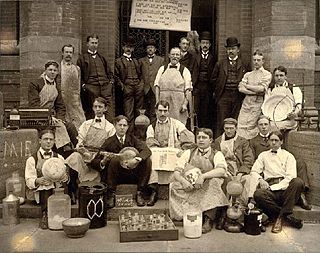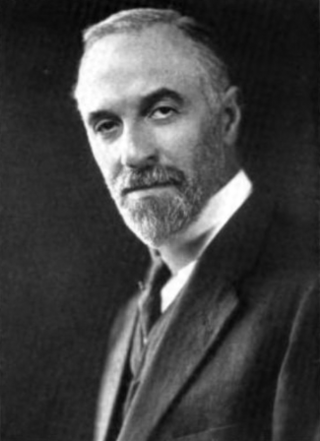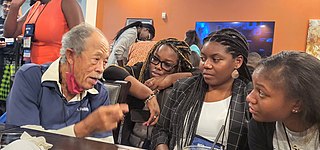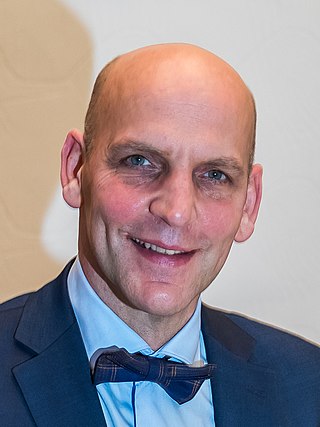
Stuart Schreiber, Ph.D. is the Morris Loeb Research Professor at Harvard University, a co-Founder of the Broad Institute, Howard Hughes Medical Institute Investigator, Emeritus, and a member of the National Academy of Sciences and National Academy of Medicine. He currently leads Arena BioWorks.

Treat Baldwin Johnson was an American organic chemist and Sterling Professor at Yale University from 1928–1943.
The National Organization for the Professional Advancement of Black Chemists and Chemical Engineers or NOBCChE is a nonprofit, professional organization. NOBCChE's goal is to increase the number of minorities in science, technology, and engineering fields. The organization accomplishes this by creating bonds with professionals working at science-related companies and faculty at local school districts in order to get more minorities to pursue a career in science and engineering fields. NOBCChE focuses on establishing diversity programs for the professional development of young kids and to spread knowledge in science and engineering. NOBCChE chapters can be found nationwide.

Peter B. Dervan is the Bren Professor of Chemistry at the California Institute of Technology. The primary focus of his research is the development and study of small organic molecules that can sequence-specifically recognize DNA, a field in which he is an internationally recognized authority. The most important of these small molecules are pyrrole–imidazole polyamides. Dervan is credited with influencing "the course of research in organic chemistry through his studies at the interface of chemistry and biology" as a result of his work on "the chemical principles involved in sequence-specific recognition of double helical DNA". He is the recipient of many awards, including the National Medal of Science (2006).

Julius Oscar Stieglitz was an American chemist of German Jewish origin. He was a teacher and organic chemist with a major interest in pharmaceutical and medicinal chemistry. He is known for the Stieglitz rearrangement, a rearrangement reaction in organic chemistry which commonly involves the formation of imines from hydroxylamines through a carbon to nitrogen shift, comparable to the key step of a Beckmann rearrangement.
Lloyd Noel Ferguson was an American chemist.
Laura Lee Kiessling is an American chemist and the Novartis Professor of Chemistry at the Massachusetts Institute of Technology. Kiessling's research focuses on elucidating and exploiting interactions on the cell surface, especially those mediated by proteins binding to carbohydrates. Multivalent protein-carbohydrate interactions play roles in cell-cell recognition and signal transduction. Understanding and manipulating these interactions provides tools to study biological processes and design therapeutic treatments. Kiessling's interdisciplinary research combines organic synthesis, polymer chemistry, structural biology, and molecular and cell biology.
Melanie Sarah Sanford is an American chemist, currently the Moses Gomberg Distinguished University Professor of Chemistry and Arthur F. Thurnau Professor of Chemistry at the University of Michigan. She is a Fellow for the American Association for the Advancement of Science, and was elected a member of the National Academy of Sciences and the American Academy of Arts and Sciences in 2016. She has served as an executive editor of the Journal of the American Chemical Society since 2021, having been an associate editor of the since 2014.
Teixobactin is a peptide-like secondary metabolite of some species of bacteria, that kills some gram-positive bacteria. It appears to belong to a new class of antibiotics, and harms bacteria by binding to lipid II and lipid III, important precursor molecules for forming the cell wall.

Malika Jeffries-EL is an American chemist and professor of chemistry at Boston University studying organic semiconductors. Specifically, her research focuses on developing organic semiconductors that take advantage of the processing power of polymers and the electronic properties of semiconductors to create innovative electronic devices. She was elected as a Fellow of the American Chemical Society in 2018.
Elizabeth Marie Nolan is an American chemist and associate professor at Massachusetts Institute of Technology.

Peter J. H. Scott FRSC CChem is a British and American chemist and radiochemist who is a professor of radiology, professor of pharmacology and professor of medicinal chemistry, as well as a core member of the Rogel Cancer Center at the University of Michigan in the United States. He is Chief of Nuclear Medicine and director of the University of Michigan Positron Emission Tomography (PET) Center, and runs a research group developing new radiochemistry methodology and novel PET radiotracers.

William Morgan Jackson is a Distinguished Research and Emeritus Professor of Chemistry at University of California, Davis and pioneer in the field of astrochemistry. His work considers cometary astrochemistry and the development of laser photochemistry to understand planetary atmospheres. He is a Fellow of the American Association for the Advancement of Science, the American Physical Society and the American Chemical Society. In addition to contributing research work, he is notable as a mentor and advocate for increasing minority participation in science where he was a founders of the National Organization for the Professional Advancement of Black Chemists and Chemical Engineers (NOBCChE).

LaShanda Teresa James Korley is a Distinguished Professor of Materials Science at the University of Delaware and an expert in soft matter, polymers, and nature-inspired materials. On a larger scale, Korley is also working on developing strategies and technologies to prevent plastic waste in landfills and oceans by upcycling plastic waste to more valuable products. She leads such efforts through the Center for Plastics Innovation, the Center for Research in Soft Matter and Polymers, and also the Center for Hybrid, Active, and Responsive Materials (CHARM). Korley was awarded the 2019 National Organization for the Professional Advancement of Black Chemists and Chemical Engineers Lloyd N. Ferguson Young Scientist Award for Excellence in Research.
Davita L. Watkins is an associate professor of chemistry at the University of Mississippi, where her research interest is in developing supramolecular synthesis methods to make new organic semiconducting materials for applications in optoelectronic devices, as well as studying their structural, optical, and electronic properties. Her group also investigates the design of dendrimer molecules for biomedical applications.

Tetrahydroxanthones are natural products formally derived by partial reduction of xanthone. They are produced by various fungi, bacteria, and plants. Some are precursors to larger xanthone natural products. One example is neosartorin, composed of 5-acetylblennolide A and blennolide C, exhibits antibacterial activity against Gram-positive bacteria, notably including Staphylococcus aureus.
Theodore Goodson III is an American chemist who is the Richard Barry Bernstein Professor of Chemistry at the University of Michigan. Goodson studies the non-linear optical properties of novel organic materials. He was elected fellow of the American Association for the Advancement of Science in 2012 and the American Institute for Medical and Biological Engineering in 2021.

Benjamin List is a German chemist who is one of the directors of the Max Planck Institute for Coal Research and professor of organic chemistry at the University of Cologne. He co-developed organocatalysis, a method of accelerating chemical reactions and making them more efficient. He shared the 2021 Nobel Prize in Chemistry with David MacMillan "for the development of asymmetric organocatalysis".
Kathlyn Ann Parker is a chemist known for her work on synthesis of compounds, especially organic compounds with biological roles. She is an elected fellow of the American Chemical Society and a recipient of the Garvan–Olin Medal in chemistry.
Rebekka Klausen is an American chemist who is the Second Decade Society Associate Professor at Johns Hopkins University. Her research considers carbon and silicon-based nanomaterials for optoelectronic devices. She was a finalist for the 2021 Blavatnik Awards for Young Scientists.









